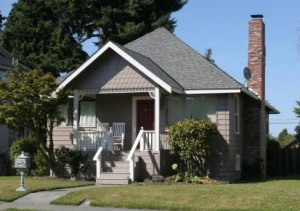We live in more space than we need. We’ve got media rooms, master suites, walk-in closets that can be mistaken for bedrooms, and extra living and dining areas. I grew up in a house with formal living and dining rooms that were reserved for company and holidays. I never understood that. It eventually dawned on my parents that they actually lived in about 1000 square feet, and they built their final house accordingly.
As a single 30-something, I built a 16′x24′ passive solar post and beam saltbox in New Hampshire. It had more space than I needed – full basement, two stories and a cozy reading loft on the ‘third floor.’ Utility bills were low. The sun heated it on sunny winter days, and because it was small, it did not take much wood to keep it warm at night.
My current house is about 2000 square feet, and I have raised two daughters here. The space has served us well for the last twelve years, but with one in college and the other getting ready to follow suit, it’s time to think about downsizing.
A friend of mine owns a pumice passive solar duplex, one side of which is 665 square feet. It is one bedroom with a full bath, a perfectly scaled kitchen, a living room and a storage room with a washer and dryer. The kitchen was small but complete, and the living room furniture fit in the space it was given. That is why the pumice duplex seemed so spacious.
I had this listed for sale a couple years ago, and every time I was in it, I said to myself, ‘I could live here with no kids.’ It was just enough room. If it were still for sale, I’d probably buy it.
Why do we think bigger is better? Ask yourself that as you consider the initial cost of a large home, the maintenance, cleaning requirements, utility bills, and the extra waste created by everything listed there. Do you really need more of all those things in your life?
Ecological Advantages of a smaller, more compact home
A green home is a smaller home. Compact is more eco-friendly. There are fewer materials are used to build a smaller home, which conserves energy and water. There is less waste at the construction site, saving landfill space. The footprint is smaller, taking up less precious and finite land space. Energy use is lower resulting in lower utility bills, stretching the lifespan of our natural resources.
These are actually things taken into consideration and rewarded in the various rating systems, such as LEED. A smaller, compact home will gain more points than a larger home, garnering a higher certification level.
The exception to the rule
A friend sent me an opinion piece about a 5,000 square foot home that was declared eco-friendly, because it was built with green methods and had a monthly electric bill of only $50. The point of the article was to say an ‘eco-mansion’ is not green, because it unnecessarily uses extra materials.
My friend didn’t agree. She said there is nothing wrong with a large space. She thought the green movement was going overboard to declare large homes not green.
This is a really good friend of mine, so an interesting conversation ensued. She said she and her partner need a bigger space than their 1000 sq ft home. They are both work-at-home artists, and we determined they need more studio space, not so much living space. She thought 3,000 sq ft might suit their needs, instead of separate out-buildings for studios.
There is nothing wrong with a large space as long as it’s getting used! A lot of these 5000 sq ft homes have extra living and dining areas, bedrooms that never get used, large rooms all the way around, probably useless hallways, and so on. Wasted space and materials are not eco friendly, no matter how cheap the utility bills are.
So I add that point to the idea that small homes are green homes. If you need that much space and will actually use it, then it’s not extravagant at all. But building big for the sake of building big, though, does not a green home make.
(Article source: BuildDirect.com. Read full and related articles here.)
Looking for economical, efficient house plans? Drummond House Plans has a great variety of house designs to choose from and all are fully customizable. It’s easy to find a plan that fits your needs!

